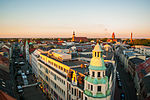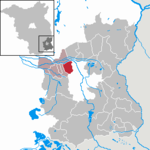Brandenburg University of Technology
1991 establishments in GermanyBrandenburg University of TechnologyBuildings and structures in CottbusTechnical universities and colleges in GermanyUniversities and colleges established in 1991 ... and 2 more
Universities and colleges formed by merger in GermanyUniversities and colleges in Brandenburg

The Brandenburg University of Technology Cottbus–Senftenberg (German: Brandenburgische Technische Universität, BTU) was founded in 1991 and is a technical university in Brandenburg, Germany with campuses in Cottbus and Senftenberg. The university has 185 professors, 640 additional academic staff and more than 7,000 students, of which 2,350 are of foreign origin from more than 100 nations.
Excerpt from the Wikipedia article Brandenburg University of Technology (License: CC BY-SA 3.0, Authors, Images).Brandenburg University of Technology
Lieberoser Straße, Cottbus - Chóśebuz
Geographical coordinates (GPS) Address Website Nearby Places Show on map
Geographical coordinates (GPS)
| Latitude | Longitude |
|---|---|
| N 51.767222222222 ° | E 14.326388888889 ° |
Address
Brandenburgische Technische Universität Cottbus-Senftenberg
Lieberoser Straße
03046 Cottbus - Chóśebuz (Ströbitz)
Brandenburg, Germany
Open on Google Maps











